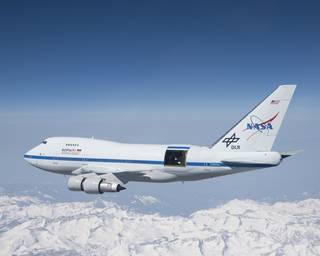You know what? I’m pretty sure NASA makes announcements fairly regularly. In fact, I’m pretty sure they always go under my radar because they are simply so regular. Yet, because it’s 2020 and it’s been a burning dumpster fire of a year, I’m just a little but more sensitive to some news. A couple of days ago, NASA announced that the Stratospheric Observatory for Infrared Astronomy (SOFIA) had discovered something about the moon. In a week where Nokia won the contract to supply 4G signal on the surface of the moon that’s two bits of news about something usually relegated to special interest magazines and websites in a week. So what’s going on?
What is SOFIA?
SOFIA is actually a modified Boeing 747 jumbo jet. The aircraft is flown by ex-military pilots and manned by scientists who control the on-board 2.7-meter reflecting telescope.

SOFIA can fly into the stratosphere at 38,000-45,000 feet, above 99% of Earth’s infrared-blocking atmosphere, allowing astronomers to study the solar system and beyond in ways that are not possible with ground-based telescopes giving a unique insight into space.
What is NASA’s Announcement About?
NASA has discovered that water is available on a sunlit surface of the moon. This is a big deal given that water was previously believed to be on the dark side of the moon but that it would not survive in more accessible areas. SOFIA’s spectrometer was able to detect the fingerprint of water on the moon and raises questions about the presence of water on the moon.
With the Artemis Mission set to land a man and woman on the moon in 2024, the presence of water on the moon would be massive.
Significance Of Water In Sunlit Areas Of The Moon
SOFIA detected water molecules in the Clavius Crater. That’s one of the big craters you can see when you look at the moon from earth, located in the Moon’s southern hemisphere. Previous observations of the Moon’s surface detected some form of hydrogen but were inconclusive as to how useful it may be. Data from the SOFIA mission reveals about a coke can worth of water trapped in a cubic meter of soil spread across the moon’s surface. In terms of significance, don’t pack your bags just yet. As a comparison, the Sahara desert has 100 times the amount of water than what SOFIA detected in the lunar soil. Despite the small amounts, the discovery raises new questions about how water is created and how it persists on the harsh, airless lunar surface.
Why Is Water On The Moon Important?
During the press conference, NASA reps gave a range of reasons why water on the moon is important. Water can be used to measure our impact on the lunar surface should we successfully man the moon. It also could potentially save on us needing to bring water to the moon, massively reducing the cost of space flight. The moon could potentially be a much more sustainable place for man should water be readily available. I should stress we’re a long way away from that kind of news emerging.
SOFIA’s follow-up flights will look for water in additional sunlit locations and during different lunar phases to learn more about how the water is produced, stored, and moved across the Moon. The data will add to the work of future Moon missions, such as NASA’s Volatiles Investigating Polar Exploration Rover (VIPER), to create the first water resource maps of the Moon for future human space exploration.


